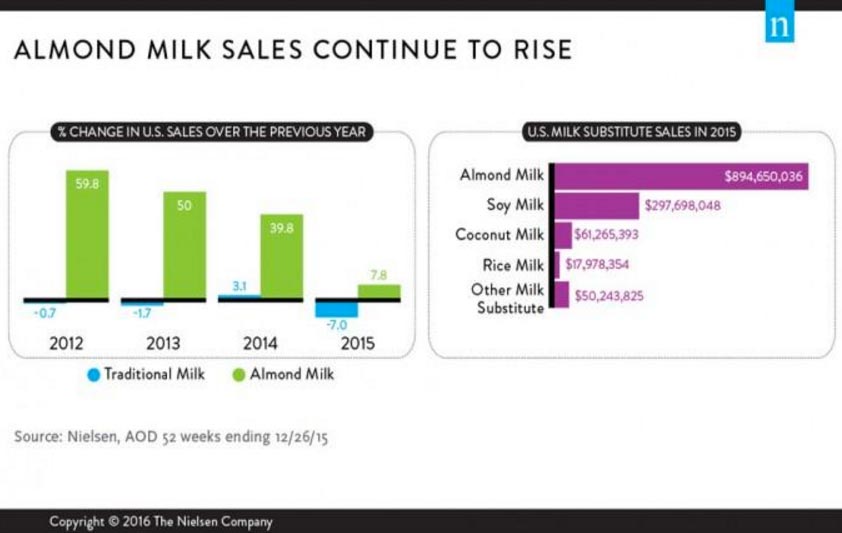According to a report carried out by Nielsen Consulting, little by little almond milk is replacing cow’s milk in the United States. According to last years’ data, while almond milk sales increased significantly (205% in the last 5 years), cow’s milk sales have been decreasing year after year. The reason for that is the consumers’ interest to buy ecofriendly, healthier, natural products.
Cow’s milk consumption is the United States has decreased 25% per capita from the mid 70’s. Nowadays, people in the USA consume an average of 37% less cow’s milk compared to 1970, according to this report by the USDA (United States Department of Agriculture). Then, if people have less amounts of cow’s milk, what are they having instead? According to the report, almond milk is replacing cow’s milk. It seems like people are choosing vegetable alternatives, such as soy milk, coconut milk, or almond milk, in accordance with the research carried out by Nielsen. Almond milk sales have shot up, increasing up to 250%, according to the report. Cow’s milk price has dropped little by little, as consumption has decreased year after year. However, this was useless since the price drops didn’t catch consumers’ attention. It is the same for milk derivatives, as consumers choose soy cheese and other vegetable options; thus, this sector has increased noticeably.
According to some people, the cow’s milk days are numbered. For the last decades it has prevailed for its health benefit, proteins and calcium; however, as consumers now know this is not the only source of calcium available, and know about its negative effects on health and the environment, they are now replacing cow’s milk for vegetable milk. Besides, consumers don’t have to worry any longer about antibiotics, hormones, and other unwanted components, as none of those are found in almond milk.
As referred to in other occasions, antibiotics are widely used to prevent animals from getting sick at farms in the United States. This poses a serious problem because, among many other unwanted consequences, pathogenic microorganisms generate antibiotic resistance. It is worth rereading the post where we talked about a report by the CDC in the USA, where we provided some data on the effects of giving antibiotics to healthy animals. As for milk cows, unlike other animals bred especially for their flesh, using antibiotics as a preventive measure is against the food security law, as drugs residues go straightaway to the milk.
Normally, controls are followed to detect any of the six most widely used antibiotics between ranchers. When one is detected, the milk sample is rejected and stored. However, ranchers have been dodging the law by using some antibiotics which cannot be detected by controls and tests, drugs that cannot be given to milk cows, according to a report by FDA (Food and Drug Administration).
Consumers don’t have to worry any longer about the cow’s milk containing antibiotics, hormones or other substances: why drinking cow’s milk if we can have other healthy, environmentally friendly options? In accordance with the report by Nielsen, almond milk is becoming important between consumers; although it’s worth mentioning that it only represents 5% of the milk sales. Nevertheless, the trend predicts great changes in the short run, as the tendency to buy healthy products which are good for our wellbeing and the environment is growing increasingly. Consumers want natural products, without food colorings, additives, drugs, or other artificial substances; vegetable milks – such as almond milk – meet all those requirements.
The latest food trends are healthier and more natural, and they are especially followed by young generations – 40% of the survey respondents belonging to the Gen Z (people born after Millennials) think it is very important to buy products coming from sustainable sources. They are followed by 38% belonging to the Millennials, 34% from Gen X, and 21% from the Silent Generation – people born between the 20’s and 40’s.
We can guess new generations will follow this pattern, so it can be stated that little by little cow’s milk sales will decrease.
Nielsen highlights another issue working in almond milk’s favor is diet, that is, it is bought by hormone intolerants – found in soy milk –, or lactose intolerants, among others. Nielsen Consulting completes the report saying that, despite the great growth of almond milk consumption from 2011 to 2014, the increase slowed down last year. However, this is only a minor setback. According to the data provided by Nielsen, almond milk sales increased 7.8% in 2015 compared to 2014; on the other hand, cow’s milk sales dropped 7%. The same happened during 2012 and 2013, where milk almond sales increased 59.8% and 50% respectively; while cow’s milk sales dropped 0.7% and 1.7%.
Taking into account that health benefits are an important factor when doing the shopping, we can predict a promising future to vegetable milks. It would be interesting if we checked the situation in Spain, since more and more people are starting to take care more about their health by eating healthy products which have been produced in a sustainable way. For further information on the research, check Nielsen’s official site.


